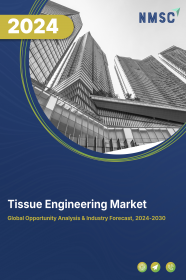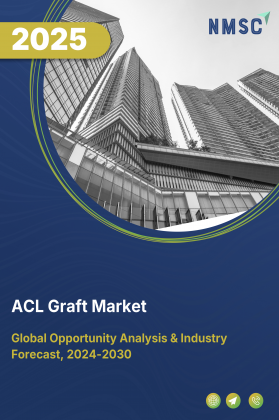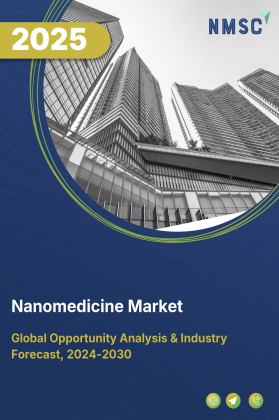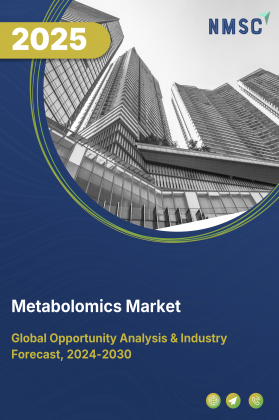
Tissue Engineering Market by Material (Biological and Synthetic), by Type of grafts (Allograft, Autograft, Synthetic, and Xenograft), and by Application (Orthopedics, Dental, Neurology, Cardiovascular, and Others), and by End-User (Hospitals and Clinics, Cosmetic Surgery Centers, Dental Practices, and other end-users) – Global Opportunity Analysis and Industry Forecast 2024-2030
Market Definition:
The Tissue Engineering Market size was valued at USD 7.99 billion in 2023 and is predicted to reach USD 17.97 billion by 2030 with a CAGR of 12.3% from 2024-2030. The tissue engineering market refers to the sector of the biomedical industry focused on the development, production, and commercialization of products and technologies aimed at repairing, replacing, or regenerating biological tissues and organs. It combines principles from engineering, biology, and medical sciences to create functional substitutes for damaged or diseased tissues. Tissue engineering offers the potential to regenerate damaged tissues and organs, leading to improved patient outcomes and reduced reliance on traditional transplant methods. Additionally, it enables personalized treatments tailored to individual patients, enhancing efficacy and minimizing complications. Therefore, tissue engineering presents a promising avenue for progressing regenerative medicine, offering hope for improved patient care and enhanced therapeutic outcomes.
Market Dynamics and Trends
The global rise in demand for tissue replacement for restoring lost function and repairing damaged tissues in chronic degenerative diseases including multiple sclerosis and alzheimer's disease (AD) is significantly driving the tissue engineering market. Tissue engineering stands out as a crucial strategy for restoring tissue function and alleviating symptoms, ultimately improving patients' quality of life. As the prevalence of these conditions escalates worldwide, there is a growing demand for innovative solutions to address tissue repair and regeneration. Consequently, institutes are strategically investing in research endeavors aimed at developing new treatments to combat the escalating cases of chronic degenerative diseases.
For instance, in April 2023, the Icahn School of Medicine at Mount Sinai in New York inaugurated the Institute for Regenerative Medicine. Its primary objective is to advance research into curing various ailments, including leukemia, Alzheimer’s disease, breast cancer, and airway diseases. The institute aims to lead new treatments, support tissue regrowth, and progress blood cancer research by combining stem cell biology efforts. Moreover, it catalyzes collaboration between researchers and clinicians, fostering an environment conducive to accelerated innovation in regenerative medicine.
Moreover, the worldwide rise in road accidents contributes significantly to the expansion of the tissue engineering market. With traumatic injuries such as burns, bone fractures, and soft tissue damage being common outcomes of such accidents, there is a heightened demand for tissue engineering solutions to address these challenges effectively.
Tissue engineering, with its innovative approaches, plays a crucial role in regenerating damaged tissues, facilitating the recovery and rehabilitation of accident victims. As the incidence of road accidents continues to rise, so does the need for tissue engineering solutions, driven by the necessity to provide effective treatment for traumatic injuries. According to a report by the World Health Organization published in December 2023, approximately 1.19 million people die due to road traffic crashes annually. This alarming statistic underscores the pressing need for advancements in tissue engineering to alleviate the burden of traumatic injuries and enhance outcomes for accident victims worldwide.
However, the challenge of achieving regulatory approval for new tissue-engineered products delays market entry, increases development costs, and hinders innovation in the field. Tissue-engineered products, involving living cells and complex structures, face stricter regulations compared to traditional drugs or devices. This involves thorough safety and efficacy testing, which can be lengthy and expensive.
On the contrary, the integration of Artificial Intelligence (AI) and machine learning algorithms to optimize tissue engineering processes, including scaffold design, cell selection, and tissue regeneration, is expected to drive the market in the coming years. By harnessing AI-driven approaches, tissue engineers can accelerate the development of innovative therapies, enhance tissue functionality, and improve patient outcomes, ultimately driving growth in the market.
Market Segmentations and Scope of Study
The tissue engineering market is segmented on the basis of material, type of grafts, application, end-user, and region. On the basis of material, the market can be divided into biological and synthetic. The biological material is further divided into collagen, hydrogel, stem cells, and others. On the basis of type of graft, market is classified into allograft, autograft, Synthetic and xenograft. On the basis of application, the market is categorized into orthopedics, dental, neurology, cardiovascular, and others. On the basis of end-user, the market is segmented into hospitals and clinics, cosmetic surgery centers, dental practices, and others. Geographic breakdown and analysis of each of the aforesaid segments include regions comprising North America, Europe, Asia-Pacific, and RoW.
Geographical Analysis
North-America holds the dominating share in the tissue engineering market and is expected to continue its dominance during the forecast period. This is primarily driven by the substantial increase in Alzheimer's cases among the geriatric population, notably in countries including the U.S. and Canada. Tissue engineering presents a promising avenue for addressing Alzheimer's disease by offering the potential for regenerating neurons and brain tissues. This approach aims to restore cognitive function and potentially slow disease progression, ultimately fostering improved treatment outcomes. With the increasing number of Alzheimer's cases, the demand for tissue engineering solutions rises in tandem. Data from the National Institute of Environmental Health Sciences (NIEHS) as of June 2022 highlights that approximately 6.7 million Americans aged 65 and above are currently living with Alzheimer's dementia in the United States. Projections indicate a potential doubling of this number, reaching 13.8 million by 2060. These statistics underscore the pressing need for advancements in tissue engineering to meet the growing demand for effective treatments in managing Alzheimer's disease, particularly in North America.
Moreover, the rising demand for neural regeneration in the United States, specifically for repairing damaged spinal cord tissues, is a key driver propelling the growth of the tissue engineering market in this region. Techniques such as creating biomaterial scaffolds to support cell growth and transplanting stem cells aim to restore function and enhance the quality of life for individuals affected by spinal cord injuries. The rise in SCI cases underscores the importance of tissue engineering in addressing these challenges. According to data from the National Institute of Health in 2022, approximately 17,000 new cases of SCI are registered annually, with an estimated 282,000 individuals living with SCI. The United States accounts for 38% of new SCIs each year, contributing to a higher prevalence of spinal implants in the region. The increasing prevalence of spinal cord injuries in the United States, coupled with advancements in tissue engineering techniques, drives the growth of the tissue engineering market in this region. These innovative approaches offer hope for individuals with SCI, promising improved outcomes and a better quality of life.
Moreover, tissue engineering market is experiencing a significant boost, propelled by the approval of government-sanctioned drugs such as lecanemab (Leqembi), Donepezil, galantamine, and rivastigmine in the U.S. and other regional countries. These drugs are specifically endorsed for treating chronic and degenerative conditions such as Alzheimer's, Parkinson's, multiple sclerosis, and muscular dystrophy. In 2023, the U.S. Food and Drug Administration (FDA) granted approval for lecanemab (Leqembi) targeted at individuals with mild Alzheimer's disease and mild cognitive impairment due to Alzheimer's disease. This regulatory action emphasizes the growing importance of innovative solutions, including tissue engineering, to address the healthcare needs associated with neurodegenerative diseases.
On the other hand, Asia-Pacific witnesses a steady rise in the tissue engineering market due to the rapid adoption of cutting-edge technologies including 3D bioprinters, aimed at advancing genomic research in the healthcare sector. For instance, in November 2022, Avay Biosciences, a startup co-founded by an IIT Madras alumnus, introduced Mito Plus, a 3D printer tailored for printing human tissues. This innovative bioprinter offers an alternative to organ transplantation by utilizing biomaterials and bioinks to fabricate functional human tissues including skin and entire organs. Such technological innovations are contributing significantly to the growth of tissue engineering in the Asia-Pacific region, enhancing its role in revolutionizing healthcare solutions and addressing critical medical challenges.
Moreover, the advancements in medical devices in the Asia Pacific region play a crucial role in driving the tissue engineering market in this region by providing the necessary tools and technologies essential for tissue engineering processes. As the medical device sector grows, tissue engineering techniques become more precise and efficient, resulting in improved outcomes and wider applications in regenerative medicine. To meet the increasing demand for medical devices tailored to tissue engineering, governments are implementing policies to support this sector. For instance, the approval of the National Medical Devices Policy, 2023, by the Government of India, reflects a strategic commitment to fostering growth in the medical devices sector. The policy aiming to elevate the sector from USD 11 billion in 2023 to USD 50 billion within the next five years, signifies a significant boost to the infrastructure supporting tissue engineering activities, thus driving the growth of the market in the Asia Pacific region.
Competitive Landscape
The tissue engineering market comprises of various market players including Organogenesis Holdings Inc., AbbVie Inc., Baxter International Inc., Terumo Corporation, Teijin Limited, Straumann Group, Integra Lifesciences, Medtronic, MiMedx Group, Inc., and TissueTech Inc. These market players are adopting various strategies such as product launches and research collaborations to maintain their dominance in the tissue engineering market.
For instance, in January 2023, BioMed X, an independent German biomedical research institute, extended its research collaboration with AbbVie, a global biopharmaceutical company. This collaboration will focus on immunology and tissue engineering, and it marks the launch of the first BioMed X Institute in the US, located in New Haven, Connecticut.
Moreover, in September 2022, MiMedx launched the AXIOFILL, an acellular human extracellular matrix derived from the placental disc. This unique product is made using a special technique that maintains the natural tissue structure and important proteins such as type I and type IV collagen, laminin, and fibronectin. The introduction of AXIOFILL represents a noteworthy expansion of MiMedx's product line, offering a distinctive collagen matrix particulate derived from human-placental tissue tailored for the surgical recovery market.
KEY BENEFITS
-
The report provides quantitative analysis and estimations of the tissue engineering market from 2024 to 2030, which assists in identifying the prevailing market opportunities.
-
The study comprises a deep dive analysis of the tissue engineering market including the current and future trends to depict prevalent investment pockets in the market.
-
Information related to key drivers, restraints, and opportunities and their impact on the tissue engineering market is provided in the report.
-
Competitive analysis of the players, along with their market share is provided in the report.
-
SWOT analysis and Porters Five Forces model is elaborated in the study.
-
Value chain analysis in the market study provides a clear picture of roles of stakeholders.
KEY MARKET SEGMENTS
By Material
-
Biological
-
Collagen
-
Hydrogel
-
Stem Cells
-
Others
-
-
Synthetic
By Type of Grafts
-
Allograft
-
Autograft
-
Synthetic Graft
-
Xenograft
By Application
-
Orthopedics
-
Dental
-
Neurology
-
Cardiovascular
-
Cardiovascular
-
Other Application
By End-User
-
Hospitals and Clinics
-
Cosmetic Surgery Centers
-
Dental Practices
-
Other End User
By Region
-
North America
-
The U.S.
-
Canada
-
Mexico
-
-
Europe
-
The UK
-
Germany
-
France
-
Italy
-
Spain
-
Denmark
-
Netherlands
-
Finland
-
Sweden
-
Norway
-
Russia
-
Rest of Europe
-
-
Asia-Pacific
-
China
-
Japan
-
India
-
South Korea
-
Australia
-
Indonesia
-
Singapore
-
Taiwan
-
Thailand
-
Rest of Asia Pacific
-
-
Rest of the World
-
Latin America
-
Middle East
-
Africa
-
KEY PLAYERS
-
Organogenesis Holdings Inc.
-
AbbVie Inc.
-
Baxter International Inc.
-
Terumo Corporation
-
Teijin Limited
-
Straumann Group
-
Integra Lifesciences
-
Medtronic
-
MiMedx Group Inc.
-
TissueTech Inc
REPORT SCOPE AND SEGMENTATION:
|
Parameters |
Details |
|
Market Size in 2023 |
USD 7.99 Billion |
|
Revenue Forecast in 2030 |
USD 17.97 Billion |
|
Growth Rate |
CAGR of 12.3% from 2024 to 2030 |
|
Analysis Period |
2023–2030 |
|
Base Year Considered |
2023 |
|
Forecast Period |
2024–2030 |
|
Market Size Estimation |
Billion (USD) |
|
Growth Factors |
|
|
Countries Covered |
28 |
|
Companies Profiled |
10 |
|
Market Share |
Available for 10 companies |
|
Customization Scope |
Free customization (equivalent up to 80 working hours of analysts) after purchase. Addition or alteration to country, regional, and segment scope. |
|
Pricing and Purchase Options |
Avail customized purchase options to meet your exact research needs. |




















 Speak to Our Analyst
Speak to Our Analyst

























